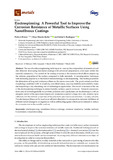Mostrar el registro sencillo del ítem
Electrospinning: a powerful tool to improve the corrosion resistance of metallic surfaces using nanofibrous coatings
| dc.creator | Rivero Fuente, Pedro J. | es_ES |
| dc.creator | Maeztu Redin, Juan Deyo | es_ES |
| dc.creator | Rodríguez Trías, Rafael | es_ES |
| dc.date.accessioned | 2021-01-11T11:43:54Z | |
| dc.date.available | 2021-01-11T11:43:54Z | |
| dc.date.issued | 2020 | |
| dc.identifier.issn | 2075-4701 | |
| dc.identifier.uri | https://hdl.handle.net/2454/38984 | |
| dc.description.abstract | The use of surface engineering techniques to tune-up the composition of nanostructured thin-films for developing functional coatings with advanced properties is a hot topic within the scientific community. The control of the coating structure at the nanoscale level allows improving the intrinsic properties of the surface compared to bulk materials. A nanodeposition technique with increasing popularity in the field of nanotechnology is electrospinning. This technique permits the fabrication of long and continuous fibres on the micro-nano scale. The good control over fibre morphology combined with its simplicity, cost-effectiveness, easy exploitability and scalability make electrospinning a very interesting tool for technological applications. This review is focused on the use of the electrospinning technique to protect metallic surfaces against corrosion. Polymeric precursors, from natural or biodegradable to synthetic polymers and copolymers can be electrospun with an adequate control of the operational deposition parameters (applied voltage, flow rate, distance tip to collector) and the intrinsic properties of the polymeric precursor (concentration, viscosity, solvent). The electrospun fibres can be used as an efficient alternative to encapsulate corrosion inhibitors of different nature (inorganic or organic) as well as self-healing agents which can be released to reduce the corrosion rate in the metallic surfaces. | en |
| dc.description.sponsorship | This work was supported by the Ministerio de Ciencia, Innovación y Universidades-Retos (Project RTI2018-096262-B-C41-MAITAI) and by the Public University of Navarre (Project PJUPNA1929). | en |
| dc.format.extent | 25 p. | |
| dc.format.mimetype | application/pdf | en |
| dc.language.iso | eng | en |
| dc.publisher | MDPI | en |
| dc.relation.ispartof | Metals, 2020, 10(3):350 | en |
| dc.rights | © 2020 by the author. Licensee MDPI, Basel, Switzerland. This article is an open access article distributed under the terms and conditions of the Creative Commons Attribution (CC BY) license. | en |
| dc.rights.uri | http://creativecommons.org/licenses/by/4.0/ | |
| dc.subject | Electrospinning | en |
| dc.subject | Nanofibres | en |
| dc.subject | Fibrous coatings | en |
| dc.subject | Corrosion resistance | en |
| dc.subject | Metallic surfaces | en |
| dc.subject | Biocorrosion | en |
| dc.subject | Composite coating | en |
| dc.title | Electrospinning: a powerful tool to improve the corrosion resistance of metallic surfaces using nanofibrous coatings | en |
| dc.type | info:eu-repo/semantics/article | en |
| dc.type | Artículo / Artikulua | es |
| dc.contributor.department | Ingeniería | es_ES |
| dc.contributor.department | Ingeniaritza | eu |
| dc.contributor.department | Institute for Advanced Materials and Mathematics - INAMAT2 | es_ES |
| dc.rights.accessRights | info:eu-repo/semantics/openAccess | en |
| dc.rights.accessRights | Acceso abierto / Sarbide irekia | es |
| dc.identifier.doi | 10.3390/met10030350 | |
| dc.relation.publisherversion | https://doi.org/10.3390/met10030350 | |
| dc.type.version | info:eu-repo/semantics/publishedVersion | en |
| dc.type.version | Versión publicada / Argitaratu den bertsioa | es |
| dc.contributor.funder | Universidad Pública de Navarra / Nafarroako Unibertsitate Publikoa, PJUPNA1929 | es |



